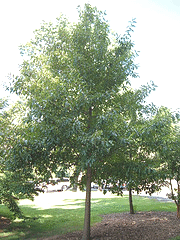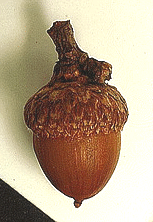Shingle Oak Trees
Shingle Oak is also known as Laurel Oak
Quercus imbricaria Shingle Oak
Zones: 5-8
Full Sun
Height: 50-75’
Spread: 60-75’
Shape: Pyramid when young, maturing to oval rounded or a gumdrop shape
Growth Rate: Slow to moderate, growing 12-18” per year.
Soil Preference: Prefers acidic soil and moist well drained, but is very adaptable
Moisture: Average moisture requirements, and is tolerant of slightly dry sites.
Foliage: Very dark lustrous green with a smooth oblong leaf.
Blooms: Yellow green catkins
Fruit: Small acorn
This tree was once commonly used by settlers to make shingles, hence the name. The Shingle Oak does not have a traditional leaf for an oak, it has a simple, smooth edged oblong leaf. Shingle Oak is very tolerant of urban conditions, is very drought resistant and tolerant of salt air. Lower branches may droop downward like the Pin Oak. They may be pruned off to allow clearance, but does enhance the graceful look of the tree if allowed to remain. The catkins are considered messy by some.
The acorns will attract a variety of wildlife including large birds, squirrels, and deer. The leaves may turn yellow or reddish in fall. Fall color is generally an unspectacular brown, and the leaves persist through winter. Shingle Oak is sensitive to transplant in autumn, it is best to plant in spring. Then it transplants easily, even though it has a taproot. It will adapt and reestablish fairly quickly. Shingle Oak has good pest resistance, and most pests will not affect the long term health of the tree, but it is susceptible to oak wilt. It is very wind tolerant, making it a good choice for windbreaks or screening. Shingle Oak is rated hardy to zone 5, but has had success in zone 4.


